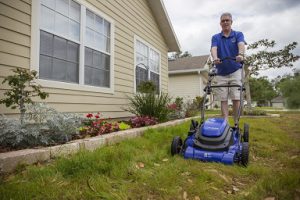It may seem laughable to most Americans that Florida does experience a “real winter”. However, there are many who are very aware that the temperatures have dropped and that their plants are reacting to this change. The Master Gardeners often receive the bulk of questions about home lawn care when temperatures in our area reach the upper and lower ends of the temperature spectrum.
Central Florida turf grasses are generally those that do well in warmer climates. During the winter, when the temperatures are relatively cooler, these grasses tend to go dormant. The leaves turn brown or they grow much more slowly than when the temperatures are warm and encouraging. These two things can distress the homeowner who has invested much time and money into their lawn.
Getting Your Lawn Through the Winter
Here are three tips to get you and your lawn through the winter with ease:

- Mow High. Mow your grass to the HIGHEST height it can tolerate. The most widely planted turf grass in Indian River County is St. Augustine grass. St. Augustine grass performs best if left as high as 4 to 6 inches. Once temperatures drop into the seventies, St. Augustine grass may stop actively growing. It is perfectly fine not to mow the lawn for a month or two while it is dormant. However, weeds may become more visible and continue to grow, making winter an excellent time to pull them.

Pop-up, in-ground sprinkler head for a home irrigation system. UF/IFAS photo by Tyler Jones - Reduce watering. Your turf is not actively growing at this time and will require much less water. Excessive watering during the winter is a contributing factor in the development of rotting roots. Too much moisture may encourage large pest colonies – fungal diseases, weeds, and insects can thrive in excessively moist turf.

Gardener fertilizing yard. UF/IFAS file photo - Avoid fertilizer applications in dormancy. If the turf is not actively growing, it will not require food. Save the fertilizer for spring when the temperatures warm back up and your grass revives. It will give your mower a good workout then.
Following these three simple suggestions will help you manage your Florida Friendly lawn efficiently this winter season.
For much more information on lawn care in winter, please visit the University of Florida’s Institute of Food and Agricultural Sciences Electronic Data Information Source (UF/IFAS EDIS) publications entitled:
“St. Augustinegrass for Florida Lawns” ENH5/LH010
“Watering Your Florida Lawn” LH025
“Mowing Your Florida Lawn” ENH10/LH028
“Homeowner Best Management Practices for the Home Lawn” ENH979/EP236
 0
0


